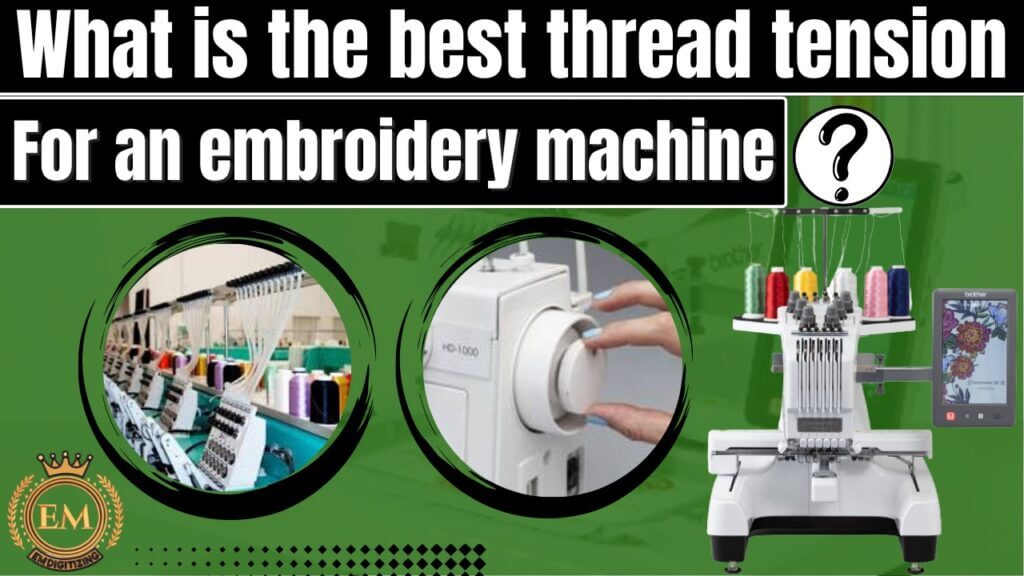What Is The Best Thread Tension For An Embroidery Machine
Embroidery thread tension is one of the most frustrating topics within the world of embroidery and learning to adjust and maintain fine balanced embroidery thread tension is an art that must be perfected.

Once you develop this skill it will make a big difference in your production and the quality of your finished embroidery. Very often embroidery designs will look a lot better if only the tension is rightly adjusted on the machine. The wrong tension can cause multiple issues and without the basic know-how of the relationship between the top and bottom threads, it is not possible to know how to correct them.
A stitch is formed when the needle carrying the top thread passes down through the needle hole in the needle plate and joins with the bobbin thread. A loop is formed behind the needle’s eye directly. As the needle is coming back up the thread will tighten if your tensions are set correctly. If one of your threads is too tight, chances are they will snap. If there is a burr on the needle hole’s edge in the needle plate, as the thread is coming back up, it could fray or split. It is vital to keep a complete balance between your upper thread and lower thread.
What is the Correct Embroidery Thread Tension?

The correct embroidery thread tension is a balance between being too tight and too loose. Ideally, the thread should be tight enough to produce smooth and even stitches, but not so tight that it causes the fabric to pucker or the thread to break. The recommended starting point for adjusting the tension is usually the middle setting on the tension dial or screw of the embroidery machine. Testing the tension on a scrap piece of fabric before starting a project is a good way to ensure the desired results.
Here are some typical scenarios when your embroidery thread tension will need to be adjusted:

- Thread breakage: If the thread breaks frequently, the tension is probably too tight. Loosen the tension dial or screw slightly until the thread stops breaking.
- Puckered fabric: If the fabric puckers after stitching, the tension is likely too tight. Loosen the tension dial or screw until the fabric lies flat.
- Loose stitches: If the stitches look loose and the thread has a tendency to unravel, the tension is probably too loose. Tighten the tension dial or screw until the stitches are neat and secure.
- Change in fabric type or weight: Different types of fabric and different weights of fabric can affect the tension. When switching to a different type of fabric, adjust the tension accordingly to achieve the desired results.
- Change in thread type or weight: The same is true for different types and weights of thread. When switching to a different type or weight of thread, adjust the tension to match the thread.
- Machine maintenance: Regular cleaning and oiling of your embroidery machine can affect the tension. Check and adjust the tension after any maintenance work.
If your embroidery thread tensions are not correct and balanced you may experience the following problems:

- Looping: If the tension is too loose, the thread may loop on the top or bottom side of the fabric.
- Breaking thread: If the tension is too tight, the thread may break frequently during stitching.
- Puckering: If the tension is too tight, the fabric may pucker and become distorted after stitching.
- Skipped stitches: If the tension is uneven, some stitches may be tighter or looser than others, resulting in skipped or missed stitches.
- Uneven stitches: If the tension is not balanced, the stitches may appear uneven and irregular in size and spacing.
- Thread tangling: If the tension is too loose, the thread may tangle on the spool or in the machine, causing interruptions in the stitching process.
Inconsistent results: If the tension is not set correctly, the results may be inconsistent from one project to the next, leading to frustration and wasted time.
Adjusting The Top Embroidery Thread Tension:

To adjust the top embroidery thread tension, follow these steps:
- Turn off the machine and remove the hoop or frame.
- Take a small scrap piece of fabric and thread it and load it onto the machine.
- Turn on the machine and watch the stitching process. Observe the top thread and the way it interacts with the fabric and the bobbin thread.
- If the top thread is too loose, tighten the tension dial or screw on the machine until the top thread is taut but not too tight. If the top thread is too tight, loosen the tension dial or screw.
- Test the tension by stitching several lines on the scrap piece of fabric. Observe the stitch quality and adjust the tension as needed.
- Repeat this process until the top thread tension is balanced and produces smooth and even stitches.
- Once the tension is set correctly, stitch a sample project to ensure the desired results.
Please Note – The exact process for adjusting the top thread tension may vary depending on the type and model of your embroidery machine, so refer to the manual for specific instructions.
Check Your Tension When You Change The Bobbin:

It is always a good idea to check your tension when you change the bobbin. A change in the bobbin can affect the overall thread tension, as the bobbin thread is crucial to the stitch formation. Here are the steps to check the tension when you change the bobbin:
- Turn off the machine and remove the hoop or frame.
- Replace the old bobbin with a new one, making sure it is loaded correctly and the thread is running smoothly through the tension spring.
- Turn on the machine and watch the stitching process. Observe the top thread and the way it interacts with the fabric and the bobbin thread.
- If the top thread appears too loose or too tight, adjust the tension dial or screw on the machine until the top thread is balanced and produces smooth and even stitches.
- Test the tension by stitching several lines on a scrap piece of fabric. Observe the stitch quality and adjust the tension as needed.
- Repeat this process until the top thread tension is balanced and produces consistent results.
Check Your Bobbin Tension Following These Steps:

To check the bobbin tension, follow these steps:
- Turn off the machine and remove the hoop or frame.
- Remove the bobbin from the case and hold it between your thumb and index finger, with the thread hanging down.
- Gently tug on the thread to see if it moves smoothly and easily from the bobbin.
- The correct bobbin tension should allow the thread to pull from the bobbin with a slight resistance, but not so much that the thread is taut or the bobbin case is pulled away from your fingers.
- If the tension is too loose, tighten the screw on the bobbin case. If the tension is too tight, loosen the screw.
- Repeat the process of checking and adjusting the tension until the bobbin thread pulls smoothly from the case.
- Once the bobbin tension is set correctly, replace the bobbin in the machine and test the stitch quality on a scrap piece of fabric.
Closing line:
We hope now you understand the best thread tension for an embroidery machine. We hope you enjoyed reading this article as we did in writing.
If you want to customize embroidery logo digitizing, EM DIGITIZING will be your best choice. At EM DIGITIZING, we deliver the best embroidery logo digitizing services with the best quality. We offer 50% off on all our services to our potential customers on their first order. So, get a free quote now and we will get in touch with you.
Hope this article will be helpful for you guys!
If there’s any question related to this article feel free to comment to us. And, thanks for reading!
To determine if the thread tension is correct, you can perform the following tests:
– Check the stitch quality: The stitches should be smooth and even, with no loops or gathers on either the top or bottom side of the fabric.
– Check for puckering: The fabric should lay flat and smooth, with no visible puckering or distorting.
– Check the stitch length: The stitch length should be consistent and uniform, with no skipped or missing stitches.
– Check the thread tension: The thread should be taut but not too tight or too loose, with no tangles or thread breakage.
If any of these conditions are not met, adjust the thread tension until the desired results are achieved. You may need to repeat this process several times to find the correct tension setting for your specific machine and thread type.
Yes, typically thicker thread will require more tension. Thicker thread has more weight and bulk, which can cause it to pull away from the fabric or create loops on the bottom side. Increasing the tension will help keep the thread taut and maintain the correct stitch formation.
However, the exact amount of tension needed will depend on the type of fabric, the design, and the specific machine and thread being used. It’s always best to test the tension on a scrap piece of fabric before starting your final project to determine the correct setting for your specific circumstances.
There are several reasons why the bottom thread may be loose on an embroidery machine:
– Incorrect bobbin tension: If the bobbin tension is too loose, the bottom thread will not be tight enough to produce even stitches.
– Uneven thread spool placement: If the thread spool is not placed evenly on the spool pin, it can cause the thread to unravel and create loose stitches.
– Incorrect thread path: If the thread path is not properly guided through the machine, it can cause the thread to become tangled or kinked, resulting in loose stitches.
– Poor thread quality: If the thread is old, damaged, or of poor quality, it may be more likely to break or fray, resulting in loose stitches.
– Dirty machine: A dirty machine can cause thread to become tangled or kinked, resulting in loose stitches.
